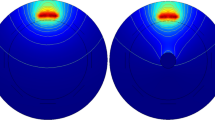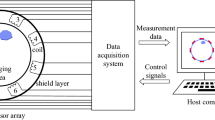Abstract
Purpose
The aim of this paper is to investigate the image reconstruction problem by using expectation maximization (EM) algorithm to enhance the quality of magnetic induction tomography (MIT).
Methods
The EM algorithm is used to solve the image reconstruction problem. It is based on the maximum likelihood criterion, and the voltage data and the sensitivity matrix are considered as the incomplete-data. Within the incompletedata framework of the EM algorithm, the image reconstruction can be converted to the problem of EM through the likelihood function.
Results
Simulation experiments are conducted and show that the proposed method has better quality of image than the Tikhonov regulation method and iteration Newton-Raphson (INR) algorithm have.
Conclusions
From the experimental results and comparative studies, we can infer the scheme applied in MIT can improve the quality of image.
Similar content being viewed by others
References
Soleimani M. Image and shape reconstruction methods in magnetic induction and electrical impedance tomography. PhD Dissertation, England, University of Manchester. 2005; 85–96, 126–48.
Korjenevsky A, Cherepenin V, Sapetsky S. Magnetic induction tomography: experimental realization. Physiol Meas. 2000; 21(1):89–94.
Yang WQ, Spink DM, York TA, McCann H. An image reconstruction algorithm based on Landweber’s iteration method for electrical capacitance tomography. Meas Sci Technol. 1999; 10(11): 1065–9.
Zolgharni M, Ledger PD, Armitage DW, Holder DS, Griffiths H. Imaging cerebral haemorrhage with magnetic induction tomography: numerical modelling. Physiol Meas. 2009; 30(6): S187–200.
Soleimani M. Simultaneous reconstruction of permeability and conductivity in magnetic induction tomography. J Electromagnet Wave. 2009; 23(5–6):785–98.
Mamatjan Y. Imaging of hemorrhagic stroke in magnetic induction tomography: an in vitro study. Int J Imag Syst Tech. 2014; 24(2):161–6.
Ma L, Hunt A, Soleimani M. Experimental evaluation of conductive flow imaging using magnetic induction tomography. Int J Multiphas Flow. 2015; 72:198–209.
Moon TK. The expectation-maximization algorithm. IEEE Signal Proc Mag. 1996; 13(6):47–60.
Zhang Y, Brady M, Smith S. Segmentation of brain MR images through a hidden Markov random field model and the expectation-maximization algorithm. IEEE T Med Imaging. 2001; 20(1):45–57.
Merwa R, Hollaus K, Scharfetter H. Numerical solution of the general 3D eddy current problem for magnetic induction tomography (spectroscopy). Physiol Meas. 2003; 24(2):545–54.
Barletta E, Dragomir S. Propagation of singularities along characteristics of Maxwell’s equations. Phys Scripta. 2014; 89(6):1–13.
Zolgharni M, Ledger PD, Griffiths H. Forward modelling of magnetic induction tomography: a sensitivity study for detecting haemorrhagic cerebral stroke. Med Biol Eng Comput. 2009; 47(12):1301–13.
Zolgharni M. Magnetic induction tomography for imaging cerebral Stroke. England, PhD Dissertation, Swansea University. 2010; 142–96.
Merwa R, Hollaus K, Brunner P, Scharfetter H. Solution of the inverse problem of magnetic induction tomography (MIT). Physiol Meas. 2005; 26(2):S241–50.
Kindermann S. Convergence analysis of minimization-based noise level-free parameter choice rules for linear ill-posed problems. Electron Trans Numer Ana. 2011; 38:233–57.
Mariappan L, Hu G, He B. Magnetoacoustic tomography with magnetic induction for high-resolution bioimepedance imaging through vector source reconstruction under the static field of MRI magnet. Med Phys. 2014; 41(2):022902–1–11.
McLachlan G, Krishnan T. The EM algorithm and extensions. 2nd ed. John Wiley & Sons; 2007.
Dempster AP, Laird NM, Rubin DB. Maximum likelihood from incomplete data via the EM algorithm. J Roy Stat Soc B Met. 1977; 39(1):1–38.
Liu Y, Nie Z, Zhao Z, Liu QH. Generalization of iterative Fourier interpolation algorithms for single frequency estimation. Digit Signal Process. 2011; 21(1):141–9.
Author information
Authors and Affiliations
Corresponding author
Rights and permissions
About this article
Cite this article
Han, M., Xue, Y. Application of expectation maximization algorithm in magnetic induction tomography. Biomed. Eng. Lett. 5, 221–228 (2015). https://doi.org/10.1007/s13534-015-0192-0
Received:
Revised:
Accepted:
Published:
Issue Date:
DOI: https://doi.org/10.1007/s13534-015-0192-0




